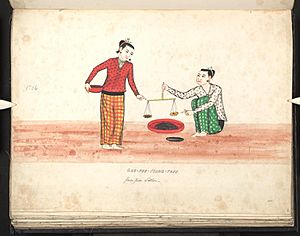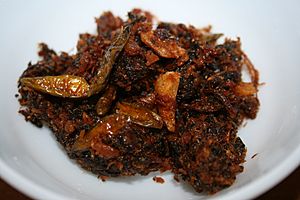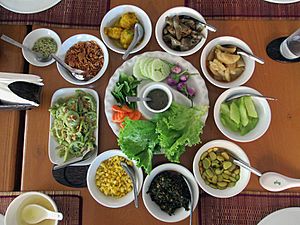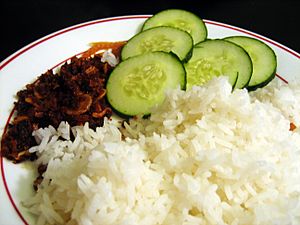Ngapi facts for kids
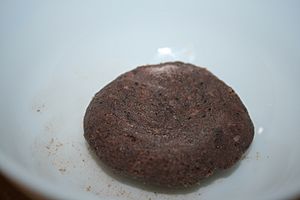
Raw ngapi
|
|
| Alternative names | ငါးပိ |
|---|---|
| Type | Paste |
| Place of origin | Myanmar |
| Associated national cuisine | Burmese cuisine |
| Main ingredients | Fish or shrimp |
| Similar dishes | Ngachin, Shrimp paste, pla ra, padaek, prahok, bagoong, shiokara |
Ngapi (Burmese: ငါးပိ [ŋəpḭ]) is a special paste from Myanmar. It is made from either fish or shrimp. People often call it "pressed fish" because of how it's made.
Ngapi is usually made by fermenting fish or shrimp. First, the fish or shrimp are salted and ground up. Then, they are left to dry in the sun. Just like different types of cheese, ngapi can be different based on what it's made from and where it comes from.
You can find ngapi made from whole fish, small fish, or even prawns. It's a very important ingredient in cooking in Lower Burma, which is the coastal part of Myanmar. People use it in many dishes, either as a flavor or as a side dish. Usually, raw ngapi is not eaten by itself.
Similar fermented seafood pastes are popular in other Southeast Asian countries. These include belacan from Malay cuisine, kapi and pla ra from Thai cuisine, padaek from Laos, and prahok from Cambodia.
Contents
What Does Ngapi Mean?
The word Ngapi comes from the Burmese language. It is a compound word that literally means "pressed fish."
Other languages have borrowed this term. In Thai, Lao, and Khmer languages, it became "kapi." However, in these languages, kapi usually means shrimp paste, not fish paste. In the Mon language, ngapi is called harok, which is similar to the Khmer word prahok for fermented fish paste.
A Look Back: The History of Ngapi
Ngapi has been a part of Myanmar's history for a very long time. Southeast Asia is known for having many different kinds of fermented fish products. The oldest record of "ngapi" is a Mon stone inscription from the 1st century CE. This shows how old it is!
Records from the 1100s to 1400s also mention people who made ngapi. By the 1400s, the Mon people had a system for trading ngapi. They would trade ngapi, salt, and rice for valuable items like rubies, benzoin, and musk from the Bamars in Upper Myanmar.
Trading ngapi was very important for the economy before Myanmar became a colony. It was even given as a special gift from Mon kingdoms to the Konbaung kingdom. In 1880, a scholar named Pho Hlaing wrote about how ngapi might help with digestion.
During the time of British rule in Burma, European visitors noticed how important ngapi was in Burmese food. They often described its smell as very strong.
How Ngapi Is Used
Ngapi is a key ingredient in the cooking of Lower Myanmar, which includes the areas near the sea. It wasn't always a main ingredient in traditional Upper Burmese cooking. However, with better transportation today, ngapi has become more popular everywhere in Myanmar.
People use ngapi in many different ways. You can eat it baked or roasted by itself. It can also be made into a watery sauce called ngapi yay. Sometimes, it's used in salads or mixed with chili. It can even be fried, like balachaung. Ngapi is also used as a base for soups and in main dishes.
Ngapi from Different Regions
- Rakhine ngapi (ရခိုင်ငါးပိ) - This type of ngapi comes from Rakhine State. It has very little or no salt. Since the Arakanese people live by the sea, they mostly use fish from the ocean to make it. Rakhine ngapi is used as the soup base for a famous Rakhine dish called mont di (မုန့်တီ).
- In the Ayeyarwady and Tanintharyi areas, most ngapi is made from freshwater fish. This type of ngapi usually has a lot of added salt. It is more common in Myanmar, and people are used to its saltier taste compared to the Rakhine version. Ngapi from Myeik is very well known and is even saltier.
Other Dishes Made with Ngapi
People in Myanmar have created many ways to enjoy ngapi. Here are some of them:
- Seinza ngapi (စိမ်းစားငါးပိ) - This type of ngapi is usually made with shrimp. It is special because it can be eaten raw.
- Ngapi daung (ငါးပိထောင်း, meaning pulverized ngapi) - For this dish, ngapi is baked or roasted in a pan without oil. Then, it is pounded in a stone mortar with garlic and red or green chili. The exact recipe can change depending on the family or region.
- Ngapi yay (ငါးပိရည်, meaning runny ngapi) - This is a very important part of Karen and Bamar cooking. The ngapi (usually whole fish ngapi) is boiled with onions, tomato, garlic, pepper, and other spices. The result is a greenish-gray sauce that looks like broth. Many Burmese families have this sauce at their dining table. Fresh or lightly cooked vegetables and fruits, like mint, cabbage, tomatoes, green mangoes, and chili, are dipped into the ngapi yay and eaten. This is similar to Thai nam phrik. For some families, ngapi yay is a main dish and a key source of protein.
- Ngapi thoke (ငါးပိသုပ်, meaning ngapi salad) - This is a Burmese salad. Ngapi is mixed with lime or lemon juice, chopped onions, and chili.
- Ngapi gyet (ငါးပိချက်, meaning cooked ngapi) - This is ngapi cooked with oil and other ingredients. These ingredients can change with the seasons, like tomato, mango, chili, marian plum, or tamarind.
- Ngapi kyeik (ငါးပိကြိတ်, meaning ground ngapi) - This is a Rakhine condiment. Baked Rakhine ngapi is mixed with large green chili and garlic. It is also called ngayot kyeik (ground chili).
- Ngapi gaung (ငါးပိကောင်, meaning whole ngapi fish) - This is a type of dry, salted fermented fish. It is usually deep-fried and served with crushed dried red chilies and garlic.
- Pè ngapi (ပဲငါးပိ) - This comes from the Shan States, which are in the highlands. This ngapi is made from fermented soybeans, also called pè bok. Even though it doesn't have fish or shrimp, it's still called ngapi. Pè ngapi is used to add flavor and as a side dish in Shan and Burmese food. It can also be used to make a curry.
- Ngapi kyaw (ငါးပိကြော်; also ngapi gyaw, meaning fried ngapi) - There are many types of ngapi that are fried with different ingredients. These often include shredded shrimp flakes, onions, garlic, and chili. The texture can be like a jam or more crumbly, like balachaung. The taste can be different depending on who makes it. Ngapi gyaw is almost always served at special ceremonies in Burmese monasteries. Some ngapi kyaw dishes might not even contain ngapi at all!
Ngapi and Your Health
Since ngapi is made from fish, shrimp, or beans, it is a good source of protein. Ngapi made from ocean fish and prawns also provides iodine. Iodine is important for your body, especially for people who live far from the sea and might not get enough iodine in their diet.
Because ngapi is made with a lot of salt, it's best to eat it in moderation. This means not eating too much of it, especially if you need to watch your salt intake.
See also
 In Spanish: Ngapi para niños
In Spanish: Ngapi para niños


